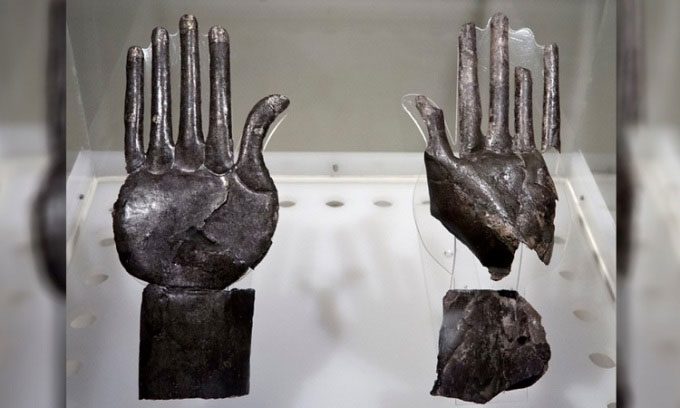Italian Researchers Discover Tomb Containing Exquisite Silver Hands, Possibly Linked to a Female Figurine from the Mysterious Etruscan Civilization.
In 2012, a team of archaeologists excavated a site in Italy aiming to rediscover an Etruscan tomb, also known as the Sun and Moon Tomb. Although they did not succeed in their primary goal, their efforts led to the remarkable discovery of the Silver Hand Tomb, according to IFL Science.

The Silver Hand reveals Etruscan burial practices. (Image: Pinterest).
Located in Vulci, approximately 120 km northeast of Rome, an expedition uncovered numerous tombs at the Necropoli dell’Osteria cemetery, dating from the 4th to the 7th centuries BCE, belonging to the Etruscan civilization that inhabited the region during that time. The cemetery features many beautifully decorated tombs, including the well-known Sun and Moon Tomb. However, the exact location of this site became unclear by the mid-18th century.
The expert team led by Carlo Casi, an archaeologist in Vulci, discovered a new site containing over 20 tombs and a large burial complex. The Silver Hand Tomb is named after the two silver hands found in the central burial chamber. The hands are remarkably preserved, particularly the left hand, which shows minimal signs of deterioration, highlighting the craftsmanship of the artisans who created them. The hands are intricately shaped, with palms open and traces of gold on the fingers and fingernails. Based on the tomb’s location within the complex and the accompanying grave goods, the research team concluded that the tomb belonged to a wealthy Etruscan family.
The Etruscan civilization thrived in Italy, reaching its peak in the 6th century BCE. This advanced civilization was known for its high level of craftsmanship and exquisite bronze artifacts. Although their origins remain a topic of debate among scholars, they were eventually incorporated into the Roman civilization that dominated the Italian peninsula. The tomb in Vulci now serves as one of the richest sources of artifacts from this long-lost civilization.
While the silver hands may appear unusual, they represent a burial ritual rooted in ancient Greek traditions. The silver hands could belong to a sphyrelaton, a wooden funerary figurine meant to safeguard the soul of the deceased after cremation or burial. Sphyrelaton can take various forms, sometimes resembling warriors or imitating the shape of the deceased. In this case, the figurine mimics a female form, possibly representing the individual interred in the tomb. The research team also discovered a purple fabric used to tie golden buttons to the outfit worn by the figurine. They further found a cluster of gold, amber, and bone beads that may have belonged to several necklaces.
Although researchers do not know the identity of the deceased, the discovery of the Silver Hand Tomb provides valuable insights into the lives and deaths of members of the long-gone Etruscan civilization.





















































